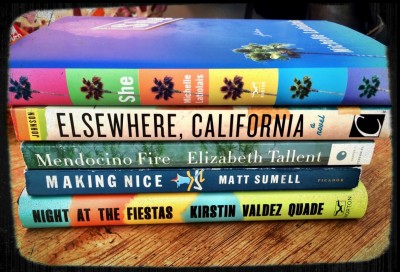
STORY:
I always tell my writing students to make a bold entrance with their stories, capture the reader’s attention, invite curiosity. Consider the first line from “Love Is Not A Pie,” this month’s story by Amy Bloom, from her collection, Come To Me.
“In the middle of the eulogy at my mother’s boring and heartbreaking funeral, I began to think about calling off the wedding.”
Bang! I’m in. Funeral and wedding, boring and heartbreaking, this is a narrator with a story I want to hear. Bloom moves us from the funeral to the house for the mourners to gather and then back in time to an idyllic summer at this family’s lakeside cabin in Maine. She captures the easy elegance of the lost mother, the heart of this family, who’s summer outfit is a black swimsuit, who makes sangria on rainy days and has three simple rules of summer: “Don’t eat food with mold or insects on it; don’t swim alone; don’t even think of waking your mother before 8:00 A.M. unless you are fatally injured or ill.”
The vacation unfurls with lake swims and romps in the woods, family friends come to stay, Mr. DeCuervo and his daughter, who blend with the family beautifully. Billie Holiday, Sam Cooke and Aretha Franklin play on the stereo, and the narrator, Ellen, notices something different about the relationships between the three grownups. When everyone dances together in the living room, her mother and father dance goofily, but between Mr. DeCuervo and her mother there is intimacy and beauty in their movements. Later, Ellen, catches her mother embracing Mr. DeCuervo in the night, her hand beneath his white t-shirt, and she is curious, uncertain. Before the summer’s end, the daughter glimpses something in her parent’s bedroom and again, doesn’t quite know what to make of the adult’s behavior. Time moves seamlessly forward, back to the mourners where Ellen and her sister discuss that summer at the cabin, their mother’s slow demise, and her relationship with the two men. As much as I want to talk about this with you, to say more…I’m holding back. All you need to know is that this story explores the huge capacity of our hearts.
When the mother is dying, she has a conversation with her daughter Lizzie, who wonders about Mr. DeCuervo. The mother says, “Love is not a pie, honey.” She goes on to explain that she loves people differently, her two men, her two daughters. “And when the two of them are in the same room together and you two girls are with us, I know that I am living in a state of grace.” After you’ve read, “Love Is Not A Pie,” and PLEASE, do yourself a favor and read this beautiful story, talk to me in the comments below.
DINNER:
How to match the grace of this mother and the big heart of this story? With a galette of course, almost a pie, but more forgiving, more generous. It comes to the table with its free form elegance, the tender crust offering homey comfort for the sweet and savory. I was delighted to find two wonderful galette recipes in the New York Times and I made them both with a few modifications.
For the Summer Vegetable Galette, I replaced the white flour with buckwheat flour with terrific results. I used all the vegetables they recommended in the recipe, though you could easily switch things around as the seasons change. I imagine a very delicious Autumn Vegetable Galette with butternut squash and chantrelles and a sprinkle of blue cheese.

Peaches, nectarines and chester berries filled my Fruit Galette. I omitted the sugar, replaced the cream with maple syrup, used whole wheat pastry flour in place of white. And, I substituted 1/3 cup of the flour with 1/3 cup of ground walnuts. Delicious!

All you need to complete the meal, lightly dressed salad greens, and someone you love. (It helps if the someone you love, loves to eat and lets you know it!) In honor of Lila, the mother in the story, I’d suggest serving Sangria. Happy reading, happy eating and happy end of summer.


